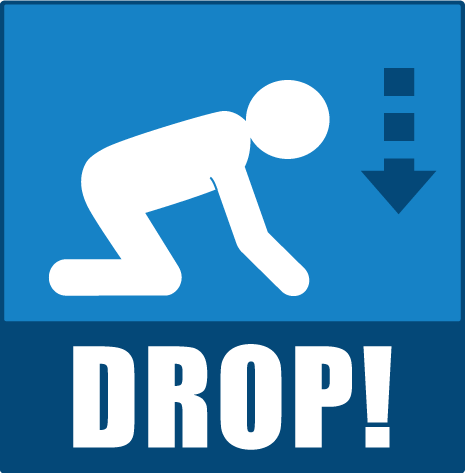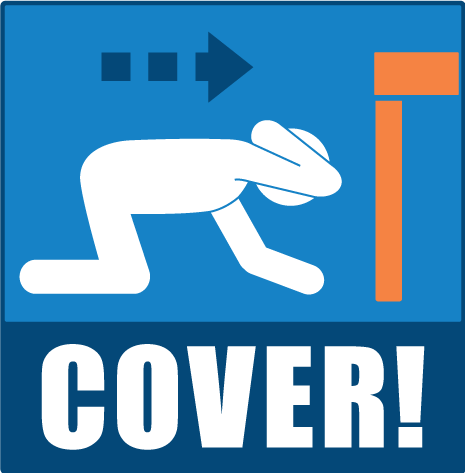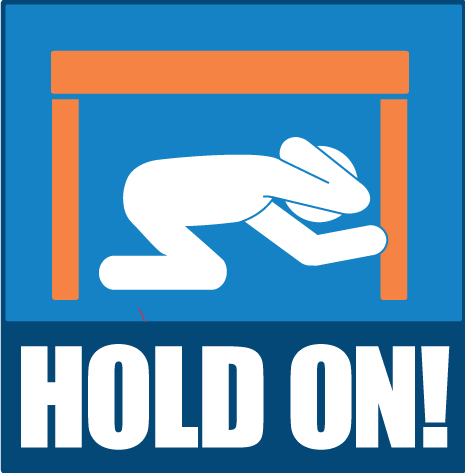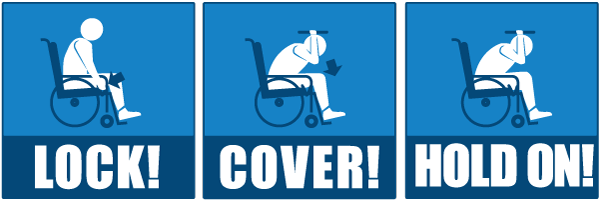Utah is Earthquake Country– Utah has experienced sixteen earthquakes greater than magnitude 5.5 since pioneer settlement in 1847, and geologic studies of Utah’s faults indicate a long history of repeated large earthquakes of magnitude 6.5 and greater prior to settlement. Utah is not on a boundary between tectonic plates where most of the world’s earthquakes occur but rather is in the western part of the North American plate. However, earthquakes in Utah are indirectly caused by interactions with the Pacific plate along the plate margin on the west coast of the United States. Also, many small earthquakes in east-central Utah are induced by underground coal mining.
What to do- In MOST situations, you will reduce your chance of injury if you:



| DROP where you are, onto your hands and knees. This position protects you from being knocked down and also allows you to stay low and crawl to shelter if nearby. | |
COVER your head and neck with one arm and hand If a sturdy table or desk is nearby, crawl underneath it for shelter. If no shelter is nearby, crawl next to an interior wall (away from windows)Stay on your knees; bend over to protect vital organs | |
| HOLD ON until shaking stops Under shelter: hold on to it with one hand; be ready to move with your shelter if it shifts. No shelter: hold on to your head and neck with both arms and hands. |
If an earthquake happens, protect yourself right away.
- If you are in a vehicle, pull over and stop. Set your parking brake.
- If you are in bed, turn face down and cover your head and neck with a pillow.
- If you are outdoors, stay outdoors away from buildings.
- Do not get in a doorway.
- Do not run outside.
It is important to think about what you will do to protect yourself, wherever you are, when the earth begins to shake. What if you are driving, in a theater, in bed, at the beach, etc.?
Persons with Disabilities: Please refer to this resource for recommendations for people who use wheelchairs, walkers, or who are unable to drop to the ground and get up again without assistance.

Indoors: Drop, Cover, and Hold On. Avoid exterior walls, windows, hanging objects, mirrors, tall furniture, large appliances, and kitchen cabinets with heavy objects or glass. However, do not try to move more than 5-7 feet before getting on the ground. Do not go outside during shaking! The area near the exterior walls of a building is the most dangerous place to be. Windows, facades, and architectural details are often the first parts of the building to break away. If you’re seated and unable to drop to the floor: bend forward, Cover your head with your arms, and Hold On to your neck with both hands.
In bed: Do not get out of bed. Lie face down to protect your vital organs, and Cover your head and neck with a pillow, keeping your arms as close to your head as possible. Hold On to your head and neck with both hands until shaking stops. You are less likely to be injured by fallen and broken objects by staying where you are.
In a high-rise: Drop, Cover, and Hold On. Avoid windows and other hazards. Do not use elevators. Do not be surprised if sprinkler systems or fire alarms activate.
In a classroom: Drop, Cover, and Hold On. Laboratories or other settings may require special considerations to ensure safety. Students should also be taught what to do at home or other locations.
In a store: Drop, Cover, and Hold On. Getting next to a shopping cart, beneath clothing racks, or within the first level of warehouse racks may provide extra protection. For more details, download a simple PDF fact sheet about Earthquake Safety in Stores.
Outdoors: Move to a clear area if you can safely do so. Avoid power lines, trees, signs, buildings, vehicles, and other hazards. Then Drop, Cover, and Hold On. This protects you from any objects that may be thrown from the side, even if nothing is directly above you.
Driving: Pull over to the side of the road, stop, and set the parking brake. Avoid overpasses, bridges, power lines, signs and other hazards. Stay inside the vehicle until the shaking stops, then proceed carefully by avoiding fallen debris, cracked or shifted pavement, and emergency vehicles. If a power line falls on the car, stay inside until a trained person removes the wire.
In a stadium or theater: Drop to the ground in front of your seat or lean over as much as possible, then Cover your head with your arms (as best as possible), and Hold On to your neck with both hands until the shaking stops. Then walk out slowly, watching for anything that could fall during aftershocks.
Near the shore: Follow the instructions above for your particular location. Then as soon as shaking reduces such that you are able to stand, walk quickly to high ground or inland, as a tsunami may arrive soon. Don’t wait for officials to issue a warning. Walk, rather than drive, to avoid traffic, debris, and other hazards.
Below a dam: Follow the instructions above for your particular location. Dams can fail during a major earthquake. Catastrophic failure is unlikely, but if you live downstream from a dam, you should know flood-zone information and have prepared an evacuation plan for getting to high ground.
Earthquake Fast Facts
Below is a list of earthquake fast facts. Did you know…
- Earthquakes strike suddenly, violently and without warning at any time of the year and at any time of the day or night.
- Smaller earthquakes often follow the main shock.
- An earthquake is caused by the breaking and shifting of rock beneath the earth’s surface. Ground shaking from earthquakes can collapse buildings and bridges; disrupt gas, electric and phone service and, sometimes, trigger landslides, avalanches, flash floods, fires and huge, destructive ocean waves (tsunamis).
- Most earthquake-related injuries result from collapsing walls, flying glass and falling objects.
- Several thousand shocks of varying sizes occur annually in the United States and 70 to 75 damaging earthquakes occur throughout the world each year. All 50 states and all U.S. territories are vulnerable to earthquakes. Where earthquakes have occurred in the past, they will happen again.
- California experiences the most frequent damaging earthquakes; however, Alaska experiences the greatest number of large earthquakes—most located in uninhabited areas.
- Earthquakes occur most frequently west of the Rocky Mountains, although historically, the most violent earthquakes have occurred in the central United States.
- The Richter Scale, developed by Charles F. Richter in 1935, is a logarithmic measurement of the amount of energy released by an earthquake. Earthquakes with a magnitude of at least 4.5 are strong enough to be recorded by sensitive seismographs all over the world. FEMA.gov
Visit the UUSS– to monitor seismic activity
Prepare Before an Earthquake
The best time to prepare for any disaster is before it happens.
- Practice Drop, Cover, and Hold On with family and coworkers.
- Secure heavy items in your home like bookcases, refrigerators, televisions, and objects that hang on walls. Store heavy and breakable objects on low shelves.
- Follow simple 7 steps to prepare your Family and HOME.
- Create a family emergency communications plan that has an out-of-state contact. Plan where to meet if you get separated.
- Make a supply kit that includes enough food and water for at least three days, a flashlight, a fire extinguisher, and a whistle. Consider each person’s specific needs, including medication. Have extra batteries and charging devices for phones and other critical equipment. Do not forget the needs of pets and service animals.
- Consider obtaining an earthquake insurance policy. A standard homeowner’s insurance policy does not cover earthquake damage.
- Consider making improvements to your building to fix structural issues that could cause your building to collapse during an earthquake. READY.gov
- Visit SAFE neighborhoods
Earthquake Insurance in Utah
Earthquakes send tremors of fear through most of us. Impossible to predict, earthquakes can cause major damage to your home and personal property, not to mention the loss of human life that can occur in severe earthquakes. Earthquake insurance is one way to protect one of your most valuable assets: your home. Earthquake Insurance
Utah Financial Resources
The Utah State Historic Preservation Office can assist homeowners and communities with the seismic retrofit and repair of historic buildings through Federal and State Historic Tax Credit programs, grants provided under the Certified Local Government program, and the professional technical assistance of their Historical Architect. Preservation Utah also helps find resources to preserve old buildings and homes through a variety of loans and grants. The Salt Lake City Fix the Bricks program provides assistance to Salt Lake City homeowners with the costs of seismic structural improvements to their unreinforced masonry homes. Earthquake Utah
After the earthquake
If an earthquake has just happened, there can be serious hazards such as damage to the building, leaking gas and water lines, or downed power lines.
- Expect aftershocks to follow the main shock of an earthquake.
- Check yourself to see if you are hurt and help others if you have training. Learn how to be the help until help arrives.
- If you are in a damaged building, go outside and quickly move away from the building. If you feel unsafe, Do not enter damaged buildings.
- If you are trapped, protect your mouth, nose, and eyes from dust. Send a text, bang on a pipe or wall, or use a whistle instead of shouting to help rescuers locate you.
- Text messages may be more reliable than phone calls. Save phone calls for emergencies.
- Once you are safe, listen to local news reports for emergency information and instructions via battery-operated radio, TV, social media, or from cell phone text alerts.
- Be careful during post-disaster cleanup of buildings and around debris. Do not attempt to remove heavy debris by yourself. Wear protective clothing, including a long-sleeved shirt, long pants, work gloves, and sturdy, thick-soled shoes during cleanup.
- Register on the American Red Cross “Safe and Well” website so people will know you are okay.
What NOT to do:
DO NOT get in a doorway! An early earthquake photo is a collapsed adobe home with the door frame as the only standing part. From this came our belief that a doorway is the safest place to be during an earthquake. In modern houses and buildings, doorways are no safer, and they do not protect you from flying or falling objects. Get under a table instead!
DO NOT run outside! Trying to run in an earthquake is dangerous, as the ground is moving and you can easily fall or be injured by debris or glass. Running outside is especially dangerous, as glass, bricks, or other building components may be falling. You are much safer to stay inside and get under a table.
DO NOT believe the so-called “triangle of life”! In recent years, an e-mail has been circulated which has recommended potentially life-threatening actions, and the source has been discredited by leading experts. Read our special report to learn more. ShakeOutUtah
Additional resources
- Earthquake Informational Poster (PDF)
- Earthquake Safety at Home(PDF)
- Earthquake Preparedness: What Every Childcare Provider Should Know (PDF)
- Putting Roots in earthquake country
- Utah Geological Survey